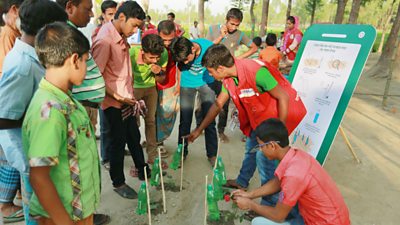Downloads
We do not know where we can seek help to solve these problems posed by disasters. We do not get any information from anyone.
Amrai Pari (Together We Can Do It) is a reality TV show that reaches 15.8 million people. It aims to help communities in Bangladesh increase their resilience against environmental hazards. New research that looks at how communities get involved in local disaster planning in their community is informing the new series of the programme.
Publication date: August 2016
The project
is a reality TV programme. It visits communities in the areas of the country most susceptible to environmental hazards and challenges them to work together with their neighbours and local traders to make their infrastructure more weather resistant and learn new resilience-enhancing techniques. By showcasing the success of real communities the programme aims to help and encourage audiences to work together in their own neighbourhoods and develop awareness about better ways to prepare against the threat of environmental hazards.
Research approach
±«Óătv Media Action’s Research and Learning team carried out a study to investigate what prevents communities from engaging in local level disaster preparedness measures in Bangladesh.
Qualitative research was conducted in three communities in Barisal, Khulna and Rangpur divisions in September and October 2015. The team collected data from focus group discussions and in depth interviews with community members and leaders. The findings were used to shape the development of content for the third series of Amrai Pari, which aimed to address this issue.
Key findings
- Lack of knowledge was preventing people from becoming involved in local level disaster preparedness plans. Community members felt that they didn’t have enough access to information and/or did not know how decisions were made about local disaster preparedness in their communities.
- Community members lacked awareness of who was responsible for these plans more broadly. They were generally unable to identify local government officials who could become members of the Disaster Management Committee (DMC) with responsibility for certain disaster preparedness issues.
- There was a lack of motivation to be involved in the community as well as a perception that participating in collective/community initiatives would not benefit community members individually.
- Sometimes, incentives such as “food for work” or “cash for work” encouraged people to step forward to participate in local preparation activities such as road or dam repairing.
- In the instances when communities did work with local government, it was typically in an emergency when a disaster hit their communal property directly, and required a prompt response to save lives and livelihoods.
- Local government members noted that there barriers to getting community members involved in local disaster preparedness, such as a lack of resources needed to launch community-level discussion groups and regular committee meetings with community representation.
Project context
The conducted by ±«Óătv Media Action identified that just over a quarter of Bangladeshis had a disaster preparedness plan for their families or local area but only 14% had ever been involved in a local village disaster committee. While community-based disaster risk reduction plans and committees exist across Bangladesh, there was a lack of awareness and engagement with them in some areas. The third series of Amrai Pari, funded through the European Commission’s Humanitarian Aid Office aimed to address these issues and showcase to audiences how they could get involved in preparing for disasters with local government officials and existing local preparedness plans and committees.
Implications
This research study helped to inform the third series of Amrai Pari in the following ways.
- It included various inspiring stories of communities working together with local government.
- It introduced viewers to the Disaster Management Committee process and planning and how it works in practice.
- It featured numerous innovative and successful alternative livelihoods so that viewers saw how local communities could adapt and cope with severe climatic events.
- Outreach activities emphasised the need to equip local NGOs and community radio stations with knowledge about local level disaster preparedness and give radio broadcasters the technical/editorial skills to produce programmes that engage people to be part of preparations.
- Training encouraged local radio stations to keep their target audiences’ needs at the top of their agenda.
